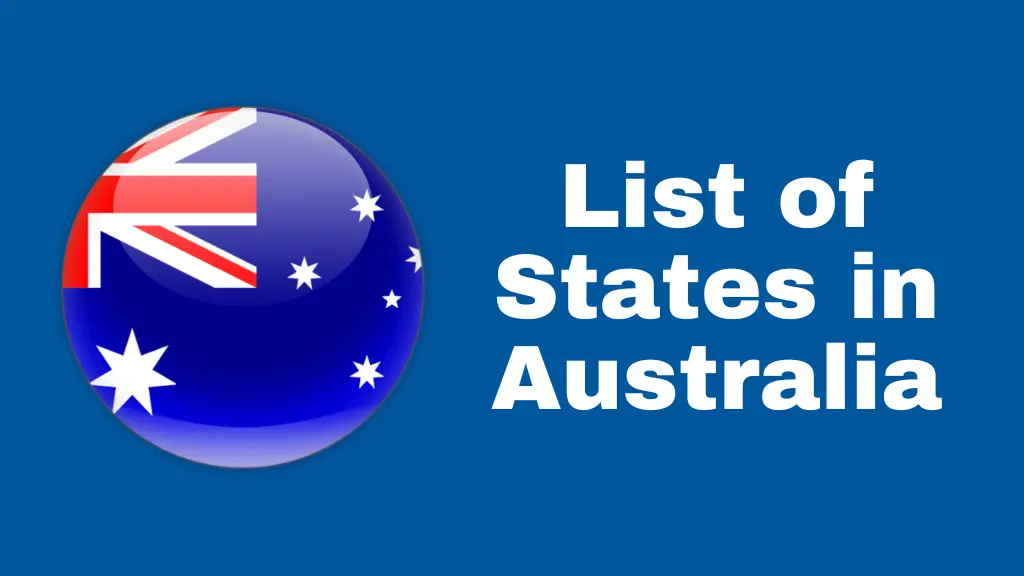Australia is one of the most unique and diverse countries in the world, shaped by its history, geography, and multicultural communities. It is divided into states and territories, each with its own identity, lifestyle, and cultural landmarks. Understanding the List of States in Australia helps readers gain deeper insight into how the nation functions politically and socially while appreciating the different landscapes that make the country so special. From the tropical climate of Queensland to the cosmopolitan hubs of New South Wales and Victoria, every state contributes to Australia’s overall story.
Australia’s states and territories not only serve as administrative divisions but also represent the soul of the country’s diversity. Each has its own cultural heartbeat, economic strengths, and iconic destinations. Together, they create a federation that balances individuality with unity, offering both residents and visitors a rich experience of natural beauty, indigenous heritage, and modern urban life.
The States of Australia
Australia is made up of six states and two main territories, each governed under the federal system. These states and territories hold constitutional power, and they also reflect the cultural and geographical diversity of the nation. Below is a detailed explanation of each state and its defining features.
New South Wales
New South Wales, often abbreviated as NSW, is the most populous state in Australia. It is home to Sydney, the nation’s largest city and a global financial hub. The Sydney Opera House and Harbour Bridge are world-renowned landmarks that symbolize both the city and the state. The state’s landscape varies from coastal regions with iconic beaches like Bondi and Manly to the rugged Blue Mountains, which are a UNESCO World Heritage site.
New South Wales has a rich colonial history, as it was the site of the first British settlement in 1788. Today, it is central to Australia’s economy, particularly in finance, tourism, education, and trade. The state also boasts renowned cultural institutions, sporting traditions, and a vibrant nightlife that makes it a magnet for both locals and international visitors. Its multicultural population adds to the state’s energy, making it a true global destination within Australia.
Victoria
Victoria is located in the southeastern part of Australia and is known for its compact size yet immense cultural and economic influence. Melbourne, the state capital, is often described as Australia’s cultural heart, famous for its art galleries, live music scene, fashion industry, and café culture. The city’s laneways, filled with street art and boutique cafés, make it a unique urban experience.
Victoria’s economy thrives on education, healthcare, technology, and innovation. The state is also a hub for sports, hosting international events such as the Australian Open tennis tournament and the Melbourne Cup horse race. Its landscapes are equally diverse, including the dramatic coastline of the Great Ocean Road, the fertile vineyards of the Yarra Valley, and the alpine regions of Mount Buller and Falls Creek for skiing. Victoria is a state where tradition meets innovation, making it a favorite destination for both tourists and residents.
Queensland
Queensland, often called the Sunshine State, is celebrated for its warm climate and natural wonders. It is home to the Great Barrier Reef, one of the seven natural wonders of the world, as well as the Daintree Rainforest, the world’s oldest tropical rainforest. Its capital, Brisbane, is a rapidly growing metropolitan city with a relaxed lifestyle, combining riverside beauty with modern skyscrapers.
Tourism is the backbone of Queensland’s economy, with millions of visitors exploring the Gold Coast, Sunshine Coast, Whitsunday Islands, and Fraser Island. Beyond tourism, agriculture and mining are also critical industries, with sugarcane, beef, and coal being major exports. The state’s natural diversity, from tropical beaches to inland savannahs and outback deserts, ensures that Queensland offers something for every traveler. Its indigenous culture is deeply connected to the land, adding to the richness of its heritage.
Western Australia
Western Australia is the largest state by land area, covering nearly one-third of the country. Its capital, Perth, is a modern and vibrant city surrounded by stunning beaches, lush parks, and a thriving arts scene. Despite its geographic isolation, Perth consistently ranks as one of the most livable cities in the world.
The state is a powerhouse of Australia’s economy, thanks to its vast reserves of natural resources. Mining, particularly iron ore, natural gas, and gold, plays a massive role in Western Australia’s exports. Yet, the state is not only about industry. Its landscapes are breathtaking, ranging from the otherworldly Pinnacles Desert to the lush wine regions of Margaret River. In the north, the Kimberley offers rugged terrain, ancient gorges, and Aboriginal rock art, making it one of the most remote yet spectacular regions in Australia.
South Australia
South Australia is often regarded as the state of festivals and fine wine. Its capital, Adelaide, is known for its arts scene, with festivals such as WOMADelaide and the Adelaide Fringe attracting global audiences. The city is also home to a thriving culinary culture, often referred to as one of the best places in Australia for food and wine.
The Barossa Valley and McLaren Vale wine regions are world-famous, producing some of the best wines that Australia exports. South Australia’s geography is equally diverse, with desert landscapes stretching into the Outback, the rugged Flinders Ranges, and pristine coastal regions like Kangaroo Island. The state also has strong defense, energy, and manufacturing industries, while being a leader in renewable energy projects. Its balance of culture, innovation, and natural beauty makes South Australia both progressive and deeply rooted in tradition.
Tasmania
Tasmania, an island state south of the mainland, is renowned for its pristine wilderness and unspoiled natural beauty. Over 40% of the island is protected as national parks and reserves, making it a paradise for nature lovers. The Tasmanian Wilderness World Heritage Area is one of the largest conservation areas in the world, preserving ancient forests, alpine landscapes, and unique wildlife.
Hobart, the capital, blends historic charm with a modern creative scene. The Museum of Old and New Art (MONA) has gained international fame for its groundbreaking exhibitions. Tasmania is also known for its cooler climate, making it an ideal place for hiking, fishing, and outdoor activities. Its agricultural produce, including cheese, wine, and seafood, is celebrated across Australia and internationally. The island’s slower pace of life and close connection to nature make it stand out from the mainland states.
The Territories of Australia
Australian Capital Territory (ACT)
The Australian Capital Territory is home to Canberra, the capital city of Australia. Designed as a planned city, Canberra is the political heart of the country, housing Parliament House, the High Court, and numerous government institutions. Beyond politics, Canberra is also a hub for culture, with landmarks like the Australian War Memorial, National Gallery of Australia, and National Museum of Australia.
The ACT is surrounded by nature reserves and mountain ranges, offering outdoor activities alongside urban sophistication. Its growing food and wine industry adds another layer of attraction, making it more than just the administrative center of Australia.
Northern Territory
The Northern Territory is celebrated for its dramatic outback landscapes and deep indigenous heritage. Darwin, its capital, is a multicultural city that thrives on its tropical climate and proximity to Southeast Asia. The city has a laid-back charm and is a gateway to some of Australia’s most stunning natural wonders.
The territory’s major attractions include Kakadu National Park, with its wetlands and Aboriginal rock art, and Litchfield National Park, known for its waterfalls and termite mounds. The most iconic landmark is Uluru, a sacred site for Aboriginal Australians, symbolizing the spiritual connection between people and the land. Mining and tourism drive much of the Northern Territory’s economy, while its cultural significance makes it an essential part of Australia’s national identity.
Importance of the States in Australia
The List of States in Australia is not only about political boundaries but also about celebrating the diversity that defines the nation. Each state and territory adds to the rich tapestry of Australia’s identity, from bustling urban hubs to quiet, untouched wilderness. Together, they create a federal system where every region has a voice, and every landscape tells a story.
Understanding this structure also helps international visitors plan their travels, students choose their study destinations, and businesses identify growth opportunities. From economic hubs like New South Wales and Victoria to natural sanctuaries like Tasmania and the Northern Territory, the states embody Australia’s balance between progress and preservation.
FAQs
How many states are there in Australia?
There are six states in Australia: New South Wales, Victoria, Queensland, Western Australia, South Australia, and Tasmania.
How many territories does Australia have?
Australia has two mainland territories, the Australian Capital Territory and the Northern Territory, along with several external territories.
Which is the largest state in Australia?
Western Australia is the largest state, covering about one-third of the nation’s landmass.
Which is the smallest state in Australia?
Tasmania is the smallest state, both in land area and population.
What makes each state unique?
Each state has its own identity shaped by its geography, industries, and culture, from New South Wales’ urban lifestyle to Tasmania’s natural wilderness.
Conclusion
Australia’s federation is built on the cooperation and individuality of its states and territories. The List of States in Australia provides more than just a political map; it represents the diverse cultures, histories, and natural wonders that define the country. Whether exploring the metropolitan hubs of Sydney and Melbourne, the natural wonders of Queensland and the Northern Territory, or the peaceful landscapes of Tasmania, every state contributes to Australia’s unique national character.
Australia is not just one land it is a collection of vibrant regions, each with its own voice, identity, and spirit. By understanding its states and territories, one can truly appreciate the nation as a whole, where tradition and modernity walk hand in hand across vast landscapes and thriving cities.





